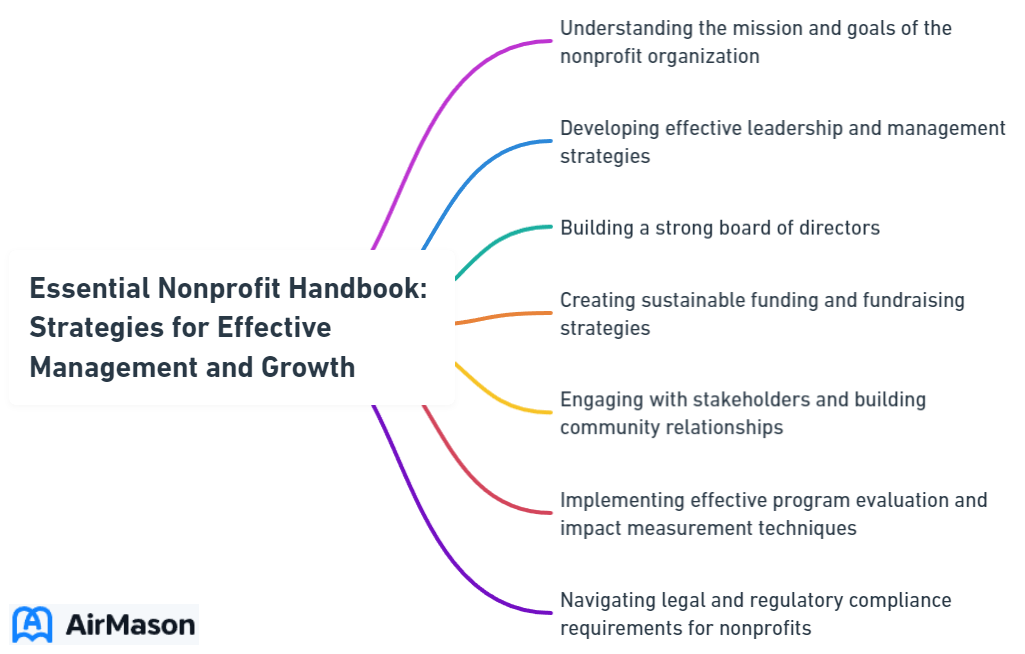
Starting a nonprofit is both an inspiring and daunting venture. This nonprofit handbook cuts directly to the chase, providing you with the actionable steps and vital knowledge for effective management and growth. Discover the essentials of forming, running, and expanding your nonprofit without getting lost in a sea of bureaucracy and regulatory requirements.
Key Takeaways
- Nonprofit organizations require a clear understanding of their mission and community benefits, along with strategic establishment steps such as defining the mission, creating a business plan, and obtaining tax-exempt status.
- Effective nonprofit governance includes forming a strong board of directors with defined roles and ensuring legal and ethical compliance to maintain integrity and navigate regulatory challenges.
- Nonprofits need robust financial management, including developing and monitoring budgets and understanding financial statements, along with impactful communication strategies and efficient volunteer management to grow and sustain.

Employee Handbook Amendments
Employee Handbook Amendments are crucial documents that outline changes, updates, or revisions to the company’s policies and procedures. These amendments serve as essential guides for employees, ensuring they are aware of any modifications that may affect their roles or responsibilities within the organization. It is imperative for both employers and employees to thoroughly review and understand these amendments to maintain compliance and alignment with company policies. Additionally, Employee Handbook Amendments often reflect legal or regulatory changes, ensuring that the company remains in adherence to relevant laws and standards. Clear communication and transparency regarding these amendments are essential for fostering a positive and productive work environment.
Understanding Nonprofit Organizations

At their core, nonprofit organizations are distinguished by their mission to serve public or social benefits, a stark contrast to their for-profit counterparts. Their unique value proposition emanates from their specific purpose and the distinct benefits they offer to the community they serve. Thus, understanding the need the organization plans to address is crucial for it to effectively fulfill its mission’s objectives.
Establishing a Nonprofit: Steps and Requirements

The process of establishing a nonprofit involves several steps:
- Naming your organization and defining its mission
- Devising a comprehensive business plan
- Incorporating your organization
- Obtaining tax-exempt status
This path necessitates thoughtful planning, strategic decisions, and a profound comprehension of your organization’s purpose.
Choosing the Right Legal Structure
A crucial waypoint on your journey is choosing the legal structure for your nonprofit. Your options include various forms, such as trusts, corporations, or associations, each with its own implications on governance, liability, and compliance. Your decision here will impact your organization’s fundraising capabilities and its ability to navigate the regulatory landscape.
It’s like choosing the right vessel for your journey – the right choice will keep you afloat through the challenges and chapters ahead.
Obtaining Tax Exempt Status
Now that your vessel is chosen, it’s time to hoist the sails and set off. Filing for tax-exempt status with the IRS will allow your organization to ride the waves of the nonprofit sector more smoothly. Once you’ve secured your status, you’ll need to maintain it at the state level, ensuring your journey stays on course.
Essential Nonprofit Governance Practices

Navigating your nonprofit’s journey requires more than just a sturdy vessel and the right paperwork. You’ll need a strong crew and a clear understanding of each crew member’s role on board. Consider your board of directors as this crew, whose strength is derived from well-defined roles, transparent practices, and an extensive understanding of the organization’s context.
Building a Strong Board
Assembling a strong board is akin to recruiting an experienced and diverse crew. You’ll need to:
- Define your needs
- Find suitable candidates
- Screen and select
- Orient them to your mission
A well-structured recruitment process is fundamental here, equipping your board to guide your nonprofit effectively towards achieving its mission.
Ensuring Legal and Ethical Compliance
Navigating the high seas of the nonprofit sector is not without its perils. Legal and ethical compliance is your compass, keeping you on the right path. It’s essential to adopt governance policies, manage conflicts of interest, and maintain legal compliance.
Remember, a smooth sea never made a skilled sailor – but a good compass sure does help.
Financial Management for Nonprofits

Financial management is the wind in your nonprofit’s sails. Robust financial policies and a variety of funding sources propel your organization forward. Remember, not all treasure is silver and gold – tracking your finances and filing your annual Form 990 are equally valuable in maintaining your nonprofit’s momentum.
Developing and Monitoring Budgets
Your budget is the map guiding your nonprofit’s financial journey. Creating, adjusting, and monitoring this map are key to staying on track. Remember, no wind favors those who have no set destination.
A well-planned budget ensures a clear destination and a set course.
Understanding Financial Statements
Financial statements are the lighthouses guiding your nonprofit’s course. They provide a snapshot of your organization’s financial health, allowing you to adjust your course as needed. The statement of activities, statement of financial position, and statement of cash flows each offer a unique perspective, ensuring you have a full view of the seas ahead.
Communications and Outreach Strategies

Effective communication is like the call of the siren, attracting and engaging your audience. Craft a compelling brand, narrate engaging stories, and utilize multi-channel marketing to captivate your audience and draw them closer to your mission.
Crafting a Compelling Brand
Your brand is the flag you fly high on your nonprofit’s mast. A well-crafted brand increases trust, loyalty, and visibility, distinguishing your organization in a sea of nonprofits. Remember, a good flag isn’t just seen, it’s recognized and remembered.
Maximizing Social Media Impact
Social media is your nonprofit’s wide net, capturing attention and inspiring action. The right choice of platforms, engaging content creation, and active follower engagement can enhance your impact, broaden your reach, and deepen your connections.
Volunteer Management and Recognition
Volunteers form the backbone of your nonprofit. Fostering a culture of philanthropy and acknowledging your volunteers’ contributions keeps the organization’s heartbeat strong.
Remember, a ship is only as good as its crew, and a nonprofit is only as good as its volunteers.
Attracting and Retaining Volunteers
Attracting and retaining volunteers parallels finding and retaining skilled sailors. It involves identifying roles, recruiting suitable candidates, and providing both training and recognition.
Sailing is a team effort, and so is running a successful nonprofit.
Recognizing Volunteer Contributions
Recognizing the contributions of your volunteers is like honoring the hard work and bravery of your crew. Regular acknowledgment and rewards foster a culture of appreciation and motivation, ensuring your crew stays dedicated and inspired. It’s essential to review their efforts and show gratitude accordingly.
Legal Resources and Support for Nonprofits
Sailing the nonprofit seas can be tricky, but you’re not alone. Legal assistance and support serve as guiding stars in your journey, aiding in navigating the intricate waters of the nonprofit sector.
Remember, every sailor needs a good navigator, and every nonprofit needs good legal support.
Finding Pro Bono Legal Assistance
Procuring pro bono legal assistance is akin to securing a skilled navigator ready to guide your vessel without charge. Several resources, from law firms to legal clinics and online directories, are available to help you steer clear of legal troubles with the aid of attorneys, even during a secure proceeding.
Navigating Online Legal Resources
Exploring online legal resources can be compared to interpreting a nautical chart. Guides, webinars, articles, templates, and more are all available at your fingertips, helping you sail smoothly through the waters of the nonprofit sector.
Staying Informed: Nonprofit News and Updates
Keeping abreast of your sector’s trends and policy changes can be likened to monitoring shifting winds and currents. By regularly checking specialized media platforms and subscribing to newsletters, you can stay up to date and navigate your nonprofit effectively.
Top Nonprofit News Sources
With the right news sources, staying updated on your sector becomes effortless. From newsletters to blogs and multimedia content, there are numerous platforms offering insights into the nonprofit world, keeping you informed and inspired.
Networking and Professional Development Opportunities
Networking and professional development opportunities can be compared to the busy ports you encounter on your journey. Conferences, webinars, and workshops provide platforms for:
- Learning
- Networking
- Gathering new ideas
- Meeting fellow sailors
- Charting your course more effectively
Senior Helpers Employee Handbook
Welcome to the Senior Helpers Employee Handbook. This comprehensive guide outlines our policies, procedures, and expectations for all employees. As a member of our team, you are an integral part of providing compassionate care and support to our clients. It is important to familiarize yourself with the contents of this handbook to ensure that you understand your rights and responsibilities within our organization. If you have any questions or concerns, please don’t hesitate to reach out to your supervisor or the human resources department for assistance. Thank you for your commitment to upholding the values and standards of Senior Helpers.
Summary
We’ve covered a lot of ground in our journey, from understanding what a nonprofit is to establishing one, ensuring good governance, managing finances, crafting an effective communication strategy, managing and recognizing volunteers, navigating legal resources, and staying informed. Remember, the open sea is a challenging place, but with the right crew, a sturdy vessel, a well-planned route, and a clear destination, you can sail your nonprofit to success.
Frequently Asked Questions
What should be in a nonprofit handbook?
An employee handbook is a crucial component of a nonprofit organization, providing guidelines, policies, and procedures for staff members.
What policies should a nonprofit have in place?
A nonprofit should have five governance policies in place, as required by the IRS Form 990. These policies are essential for the organization’s compliance and effective operation.
What is the best structure for a nonprofit organization?
The best structure for a nonprofit organization typically involves a board of directors at the top, followed by the executive director, and then various levels of management and staff. This structure helps establish a clear chain of command and transparent reporting lines.
What is the hardest part of running a nonprofit?
The hardest part of running a nonprofit is ensuring stable income and accurate budgeting, as well as the pressure to demonstrate results and strategic solutions. Attracting and retaining the right talent is also challenging.
What are the key aspects of establishing a nonprofit?
The key aspects of establishing a nonprofit include naming the organization, defining its mission, developing a business plan, incorporating the organization, and obtaining tax-exempt status.
Important Disclaimer:
Please be aware that the content on this page has been generated by using artificial intelligence language models and may contain errors, inconsistencies, or outdated information. It is provided as-is without any warranties or guarantees of accuracy.
We strongly recommend using this content as a starting point for further research. We disclaim any liability for damages or losses resulting from the use or reliance on this content.